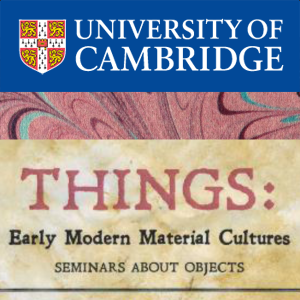Things - 11 June 2013 - Painted Things
Duration: 1 hour 16 mins
Share this media item:
Embed this media item:
Embed this media item:
About this item

| Description: |
Dr Matthew Hunter (McGill University)
Did Joshua Reynolds Paint his Pictures? Professor Mark Hallett (Paul Mellon Centre) Point Counter Point: Josua Reynolds, portraiture and late eighteenth-century exhibition culture. Abstracts Matthew Hunter. In May 1773, an open letter to London’s Morning Chronicle lodged a peculiar complaint with Sir Joshua Reynolds. Pigmented ooze—paint—had, in the view of this critic, come to bear in upon British art with undue, defacing force. The problem followed from conceptualizing artistic identity through an excessively literal translation of French Peintre as “Painter, and the materials which ingenious persons of that denomination make use of to display their talents, we have, from that word, calledpaint, which in French is named coleurs.” Closer to the liberal art actually practiced and promoted by Reynolds, this anonymous critic proposed, sculptors and architects could offer useful counter-models: “Why not like these have a peculiar name, Sir Joshua, for your very profession? Why not like these take up at once your classic name? Why not Pictor?” Situated within the rich, period discourse and extensive, modern documentation of Reynolds’s chemical experiments, this paper aims to take theMorning Chronicle’s complaint seriously. It considers the ways in which Reynolds and his contemporaries understood interfaces between paint and image, while exploring the broader stakes (then as now) of apprehending the President’s temporally-evolving chemical works as “pictures.” Mark Hallett. This talk, which will focus on the portraits submitted by Joshua Reynolds to the annual Royal Academy displays of the 1780s, explores the workings of the painted object within the crowded, ephemeral and spectacular exhibition displays characteristic of the late eighteenth century. Particular attention will be devoted to the ways in which, within the Academy's Great Room, Reynolds's individual portraits of women were played off against each other and against portraits of male subjects, and thereby became part of an extended and highly intriguing form of visual dialogue and counterpoint. |
|---|
| Created: | 2013-06-13 10:58 |
|---|---|
| Collection: | Things Seminar |
| Publisher: | University of Cambridge |
| Copyright: | Glenn Jobson |
| Language: | eng (English) |
| Keywords: | CRASSH; Things; Hallett; Hunter; |
| Abstract: | Dr Matthew Hunter (McGill University)
Did Joshua Reynolds Paint his Pictures? Professor Mark Hallett (Paul Mellon Centre) Point Counter Point: Josua Reynolds, portraiture and late eighteenth-century exhibition culture. Abstracts Matthew Hunter. In May 1773, an open letter to London’s Morning Chronicle lodged a peculiar complaint with Sir Joshua Reynolds. Pigmented ooze—paint—had, in the view of this critic, come to bear in upon British art with undue, defacing force. The problem followed from conceptualizing artistic identity through an excessively literal translation of French Peintre as “Painter, and the materials which ingenious persons of that denomination make use of to display their talents, we have, from that word, calledpaint, which in French is named coleurs.” Closer to the liberal art actually practiced and promoted by Reynolds, this anonymous critic proposed, sculptors and architects could offer useful counter-models: “Why not like these have a peculiar name, Sir Joshua, for your very profession? Why not like these take up at once your classic name? Why not Pictor?” Situated within the rich, period discourse and extensive, modern documentation of Reynolds’s chemical experiments, this paper aims to take theMorning Chronicle’s complaint seriously. It considers the ways in which Reynolds and his contemporaries understood interfaces between paint and image, while exploring the broader stakes (then as now) of apprehending the President’s temporally-evolving chemical works as “pictures.” Mark Hallett. This talk, which will focus on the portraits submitted by Joshua Reynolds to the annual Royal Academy displays of the 1780s, explores the workings of the painted object within the crowded, ephemeral and spectacular exhibition displays characteristic of the late eighteenth century. Particular attention will be devoted to the ways in which, within the Academy's Great Room, Reynolds's individual portraits of women were played off against each other and against portraits of male subjects, and thereby became part of an extended and highly intriguing form of visual dialogue and counterpoint. |
|---|---|

